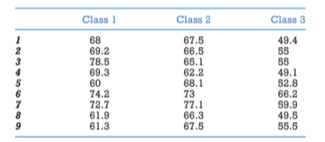Three classes of student exam scores are compiled. Using SPSS to explore the data provided, determine the following:

a. Consider the post hoc contrasts between the different groups. Do any groups stand out?
b. Using the results from part (a), test the hypothesis that mean test score of one group differs from those of the other two.
A. Using SPSS, post hoc constants are shown to have significant differences between Class 3 and
the other two classes. This is significant at a level < .001.
B. The test for homogeneity suggests that we can assume equal variances. Then, with coefficients
.5, .5, and -1, the a priori contrasts suggest a difference of 13.0 between the means, at
a significance level of less than .001. Thus, we can reject the null hypothesis and conclude
confidently that the results of Class 3 were statistically different from those of Classes 1 and 2.
You might also like to view...
A lack of ______________ makes it difficult for semi-democratic
regimes to improve the capacities of its citizens. a. well-educated university graduates to staff state offices b. state capacity c. independence from former colonial rulers d. foreign aid
One economic resource over which local communities exercise a great deal of power is land
Indicate whether this statement is true or false.
Suppose that an employee of the Small Business Administration designs an application form for a new type of small business loan authorized by Congress. This is the _____ phase of the policy making process
a. bargaining b. formulation c. agenda setting d. implementation
Television was available to consumers by the mid-1930s, but when did it become widely adopted as a medium for getting news about politics and the world?
A) prior to World War I B) during the Great Depression C) during the postwar economic boom following World War II D) during the early 1970s E) during the late 1980s